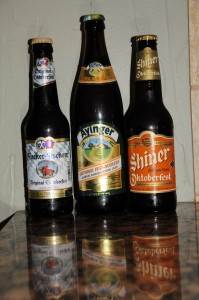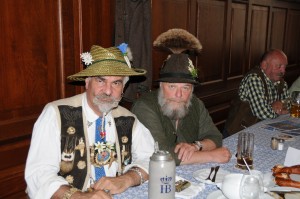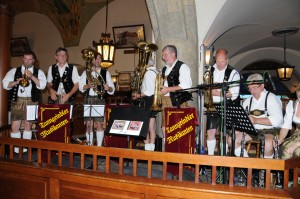 Question: When in Germany can you experience March in October? Answer: When you are in Munich drinking a Marzen beer during Oktoberfest!!
Question: When in Germany can you experience March in October? Answer: When you are in Munich drinking a Marzen beer during Oktoberfest!!
Every year at precisely noon on the first day of Oktoberfest the lord mayor of Munich steps forth for the ‘Official Tapping of the Keg’, a traditional ceremony to kick off the festival. It is one that is eagerly anticipated by beer drinkers far and wide. And the beer most associated with Oktoberfest? That would be the Marzen-style brews. The term Marzen (also spelled Maerzen; pronounced ‘Maer-tsen’, NOT ‘Mars-en’) is German for March which is when that particular style of lager is brewed. Back when Oktoberfest first began lack of refrigeration made brewing beer in the summer unheard of due to heat and bacteria issues. Brewers instead prepared their beer in March, and it usually had higher alcohol content – typically 5.0-6.2% – to aid in the preservation process. Once bottled it was put in ‘lagerns’ – German for storage – in this case caves and/or cellars. Often these lagers were located near a water source such as a pond, allowing them to harvest blocks of ice in the winter when the ponds froze over. They used the ice to keep the beer cold until it was ready to be consumed. Actually, some of these cellars are still in use to this day.
Bavarians are very serious about their beer, and VERY PARTICULAR!! Way back in 1516 a ‘purity order’ was established in Bavaria – called “Reinheitsgebot” – making it illegal for its beer to be made from anything but hops, barley-malt (originally just barley) and water. Yeast was eventually permitted as the fourth acceptable ingredient. All of Germany accepted this enactment in 1906; however, as with most rules there are exceptions…loopholes if you will. Some circumstances do allow other ingredients to be incorporated, such as sugar, wheat and even coloring.
Marzen itself is a medium to full-bodied darker lager, having a slightly sweet taste. Bitterness is usually on the low side but varies among brewers. The color may range anywhere from amber to deep copper, with tradition leaning toward the darker brews. It is the historic offering at Oktoberfest. Due to cooler weather October was the time brewers could begin making beer again. They needed to empty out the kegs to make space to store the new batches, so they let their ‘Marzen biers’ loose at Oktoberfest .
So make sure to fill your steins with a proper Marzen on this 200 year anniversary of Oktoberfest…To all of you I raise my stein and cheer ”Prost!”
FUN FACTS
**the reason barley was the only grain allowed has pretty much everything to do with the fact that they wanted to make sure the wheat and rye were reserved for bread-baking. In other words, it was protection for the bread industry.
**Ales are made with top-fermented yeast. This enables the finished product to be ready quickly, often in only a few days
**Lagers are made with bottom fermented yeast. They need cooler temperatures and take longer to reach full maturity, often 1 – 3 months. Marzen falls into this category.





